Corsair RM1000 Power Supply Review
by E. Fylladitakis on April 24, 2014 6:00 AM EST- Posted in
- Cases/Cooling/PSUs
- Corsair
- PSUs
- RM Series
Hot Test Results
From the tables below, it can be seen that the output power quality of the Corsair RM1000 is very good. The maximum voltage ripple that our instrumentation recorded was just above half of the ATX design guide suggested limit (the limits are 120 mV on the 12V line, 50 mV on the minor voltage lines), under full load and inside the hotbox. Cross-load testing negatively affects the power quality of any power supply, yet the RM1000 manages to pass the test, with the 12V line registering up to 98 mV while delivering a massive 800W.
| Main Output | ||||||||
| 203.84 W | 506.25 W | 752.95 W | 997.56 W | |||||
| 20.38% | 50.62% | 75.29% | 99.76% | |||||
| Line | Amperes | Volts | Amperes | Volts | Amperes | Volts | Amperes | Volts |
| 3.3 V | 4.14 | 3.40 | 10.36 | 3.37 | 15.53 | 3.34 | 20.71 | 3.30 |
| 5 V | 4.14 | 5.14 | 10.36 | 5.11 | 15.53 | 5.00 | 20.71 | 4.98 |
| 12 V | 13.80 | 12.21 | 34.50 | 12.13 | 51.76 | 12.04 | 69.01 | 11.97 |
| Line |
Regulation (20% to 100% load) |
Voltage Ripple (mV) | |||||
| 20% Load | 50% Load | 75% Load | 100% Load | CL1 12 V | CL2 3.3 V + 5 V | ||
| 3.3 V | 3.0% | 16 | 24 | 26 | 30 | 10 | 26 |
| 5 V | 3.1% | 18 | 26 | 30 | 36 | 12 | 30 |
| 12 V | 1.95% | 26 | 30 | 54 | 70 | 98 | 24 |
The impact that the higher ambient temperature has on the energy conversion efficiency is virtually miniscule, reducing the average nominal load (20-100%) efficiency of the RM1000 from 91.8% down to 91.4%. This is an excellent result for such a powerful power supply, especially when the ambient air temperature increased by more than 20 °C.
The large increase in the ambient air temperature naturally has an effect on all of the temperature readings. This time the fan starts a bit earlier, at 40% load, and its speed increases rapidly, obviously reacting to the high heat. The speed of the fan virtually maxes out at 70% load, with the cooling system giving everything it has to keep the RM1000 cool enough. The fan becomes clearly audible but not overly loud even while the unit is severely stressed, but its speed cannot be increased any further and so it is unable to help the thermal performance of the RM1000 beyond a certain point.
While the power supply keeps operating just fine, the temperatures are significantly elevated, above what we consider a "comfortable limit". This however also is with an ambient temperature significantly higher than the 40 °C rating of this power supply, therefore the fact that it can keep delivering its maximum output and electrically perform well enough to maintain its specifications is quite a feat.


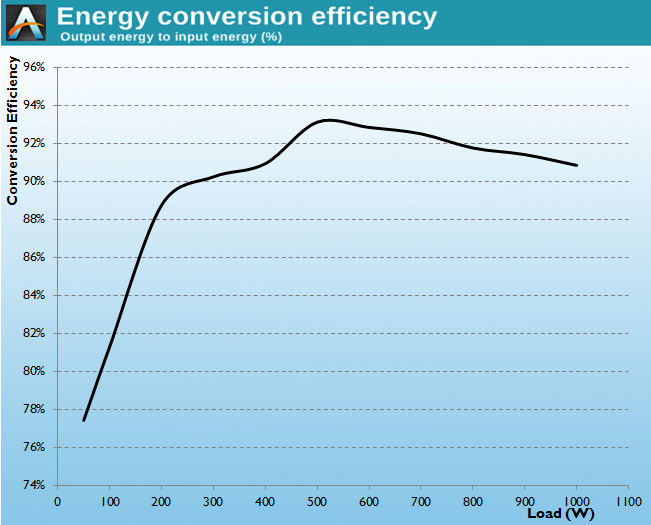
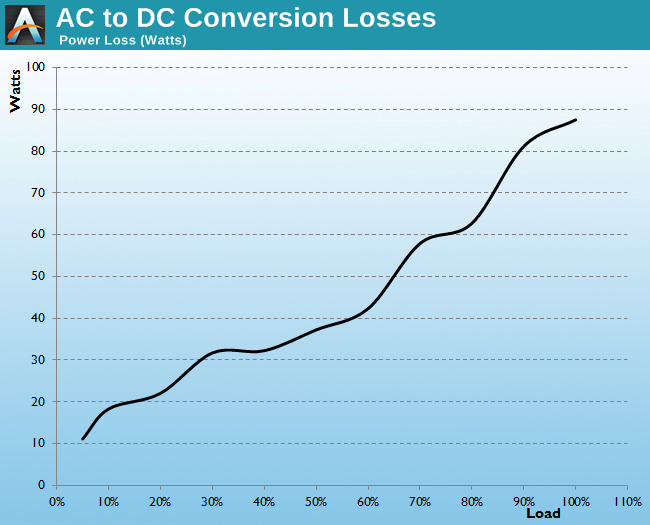
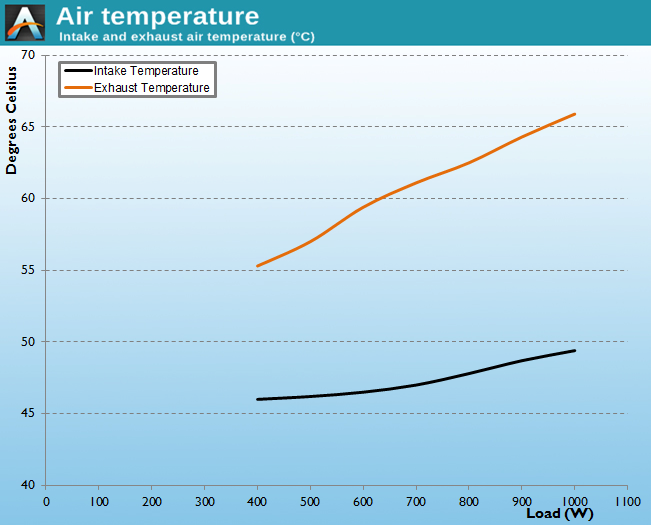
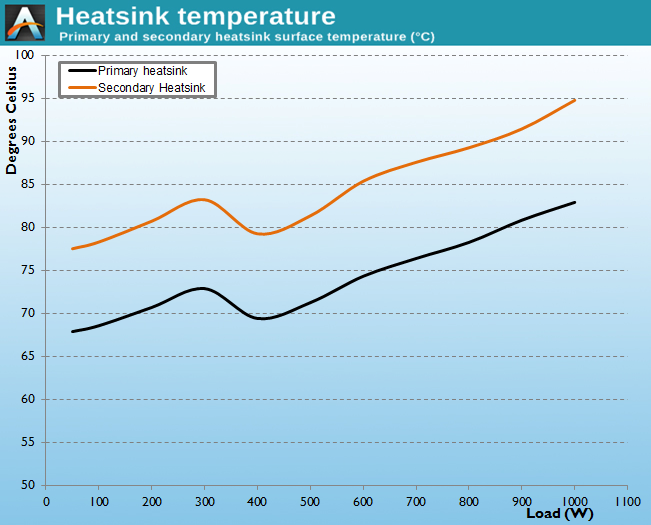
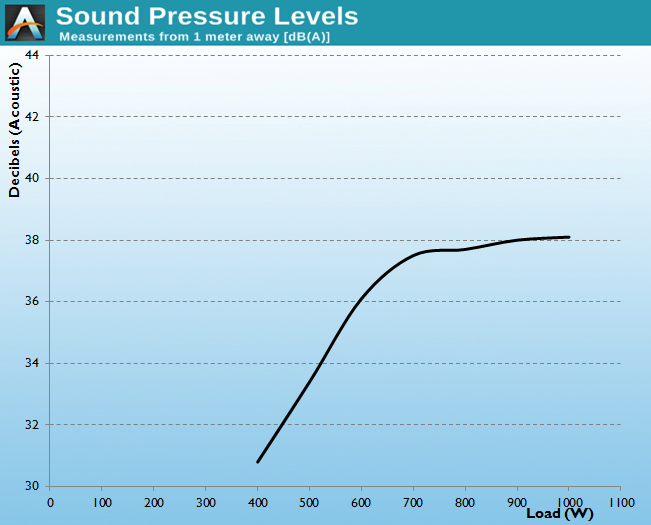








55 Comments
View All Comments
ssj3gohan - Monday, April 28, 2014 - link
Can I give some constructive criticism?The review is missing some parts that would be very useful:
- The teardown is extremely short and basically useless. All the information we get from it is that it's made by CWT. There is a lot more to see that is relevant, like the topology (it's obviously LLC resonant, otherwise the heatsinks for the active devices could never be that small even for a lower powered unit. They dissipate so little because they are switched at zero voltage and current all the time (ZVCS) instead of only half of the time (pseudoresonant) or never (traditional push-pull). Switching losses are the biggest issue in high current PSUs. Another important thing to note is the make of the controller chip(s), as this usually gives a good idea of the modern-ness of the design (LLC resonant has been around for 20 years, but only recently have they really started to do propagation time compensation and such awesomeness). It's also important to note that for instance on this unit, the non-important cap (input filter cap) is from a good brand and the caps that actually matter (high ripple current, high stress in general) are B or C grade. CapXon is not something I would trust handling a couple tens of amps of ripple current for 5 years. Lots of reviewers get fooled by the big shiny cap on the input having the good markings, but this misses the point of cap quality inspection. There's more that should be in the teardown, but for that I'd just recommend aping Jonnyguru, X-bit labs or such people.
- On the hot *and* cold tests (as well as crossload), at least include a table of the actually used loads and results in numbers, as well as your total (un)calibrated error - depending on whether all your instruments are calibrated or not.
- Don't fucking interpolate to get nice graphs! This is a deathly sin in data processing. It causes all kinds of crazy things, like implying that the slope of the efficiency graphs is a certain value at the edges (while it probably is something completely else) and causing the weird ripples in the efficiency curve you see. I'd bet money that that ripply stuff is just measurement error. In fact, the entire graphs are a big departure from both the 80 Plus test report and other review sites, so even if this is not actually an error on your part, we need to be able to properly compare this (with table values) to be sure. Even just the sentence 'this PSU was tested on 230VAC input while most other sites test at 115VAC input; this may inflate efficiency numbers' would greatly improve the review.
- This leads to the next point: interpret the data for us, give us a well-researched explanation for weirdness. Why do the SPL numbers look the way they look? Did you have a tachometer? Did the sound have a broad spectrum or was it whiny?
- Also: another case of interpolation causing weird graphs is the heatsink temperature graph. Cut that graph in the middle, and annotate it on the left with 'fan off' and on the right with 'fan on'. Don't try to connect the two separate domains, it is meaningless and just causes weird bumps in the graph that are not there!
- In the conclusion, don't just give a conclusion on this unit in a vacuum. You're a review site! You are supposed to know the market, know the competition. Tell us how the unit performs compared to the competition and how well it is priced. THEN give us a recommendation. Take into account the industry standing of the brand and previous PSUs. As it stands, the conclusion is not satisfactory.
I'm not trying to be harsh, but Anandtech has a good reputation and there are too few good PSU reviewers around on the internet. You're one of only 3 semi-fulltime PSU reviewers with a master's and/or PhD in the right area, so I have high hopes for the future. I already had high hopes when you were introduced for the first time, but the reviews so far have been passable instead of great. This needs to be fixed.
Michal Daniel - Wednesday, April 30, 2014 - link
Makes for a splendid hackintosh. Typing this on it.http://www.proofsheet.com/macbeast/all.html
amazingrugs - Friday, May 9, 2014 - link
I've been out of the building game for quite a while. I think the last system I built had a Radeon 9500, when AGP was all the rage! What kind of system does it take to push a PSU like this?alostpacket - Thursday, May 15, 2014 - link
You guys should never post after-rebate prices, you are doing their marketing for them.burningisis - Monday, November 16, 2015 - link
I think another use for a high wattage PSU like this other than mining or those using autocad... future proofing a machine. I know I've replaced enough PSUs on my machines as I upgrade GPUs or upgrade the number of drives I use or if I decide to push overclocking. I know some users are going smaller but there are users still out there demanding larger PSUs, running 3+ GPUs, running multiple processors on an enthusiast system. It may be a small subset of users, but there is a demand out there for these, and this looks like a very nice PSU to future proof a build as well